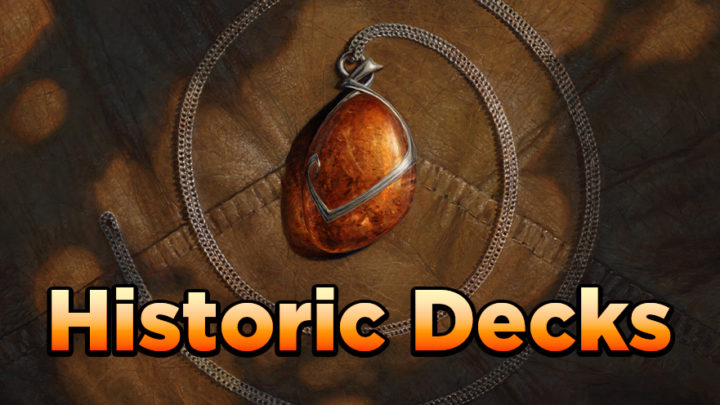Ding dong, Winota is dead (well, suspended) in Historic. It’s a great time if you enjoy brewing, especially if you enjoy brewing linear, explosive decks that make silly things happen. Oh, you do? Well, let’s cut off this preamble right here so I can fit in more lists. Get ready to tick some fun stuff off your Magic bucket list…
1. SPEND 40 MANA ON LEGENDARY SORCERIES IN ONE TURN
One easy way to start building Historic decks is to pick out an old Standard build-around you enjoyed and see what can be done with it in this slightly-deeper card pool. Even if it wasn’t quite feasible during its Standard lifetime, chances are that you can make it look extremely broken here. So it is with Kamahl’s Druidic Vow.
This card has seen precisely zero play anywhere ever, so let me rattle off some quick points which can get lost on a first read.
- It’s a Legendary Sorcery, so you need to have a legendary creature or Planeswalker in play to cast it.
- It puts all the cards you hit with it into play, untapped, for free. Including the lands.
- It puts the rest of the cards into your graveyard — not on the bottom of your library.
So, like Genesis Wave, the Vow is a ramp spell that also mills significant chunks of our deck, and potentially puts expensive legends into play for nothing. We could construct a ramp deck full of large legendary threats to slam into play, but what if the Vow itself was the threat?
Jace, Wielder of Mysteries is a legendary permanent that lets you win by decking yourself. If you have a Jace somewhere in your deck, you can focus the rest of our 75 cards on simply ramping out the largest Vows possible. Since your deck is almost entirely composed of lands and legends, you can immediately set up your next Vow, sometimes on that same turn. After a couple of these escalating, cascading Vows, you can flip over your library effortlessly, put Jace into play, and win.

When Kinnan, Bonder Prodigy was first spoiled, players immediately identified its gross synergy with Mox Amber. As an inveterate Mox Amber player myself during its time in Standard, I was very excited to have another (much better) two-drop legend to pair with Fblthp. It’s just as brutal as you’d expect.
Throw in a few non-legendary mana elves, and then it’s off to legend shopping! There’s tons of options you can scatter in here in ones and twos, and it can even be better to do so — diversifying legends means more unique hits with Vow. In the end, I kept this build tight for consistency, and it seems to pay off.
I think you get the idea.
QUICK TIPS:
- A hard-cast Uro will both trigger Kiora and allow you to briefly extract mana from a Mox Amber if you need a legend.
- Always tap/activate as many of your legends as you can before casting Vow. You may end up replacing them with fresh hits.
- Similarly, consider playing an Island from hand if it will take you up to three Islands for Mystic Sanctuary. You can use Jace or Tamiyo to draw the Vow you put back for immediate reuse.
- You usually want to Vow for at least five, to ensure you can hit anything in the deck. But once you’re above that threshold, you can go for it, and in many cases, you’ll be able to find your next Vow off the hits.
- Playing at least two copies of Jace is strongly advised, in case one is exiled. You don’t want to draw him, but if you do, it’s usually best to hold off on casting him until you finish decking yourself.
- Tamiyo is essential for digging to or buying back Vow, and sometimes recurring Jace in emergencies. You can substitute a couple for Mystic Sanctuaries, but finding room to play more of her is a fine idea.
- This deck prefers to race opponents rather than interact, but if you do want interaction, I’d recommend In Bolas’s Clutches. Rolling one or two of these off a Vow to steal their best permanents will make opponents feel like Winota and Agent are still legal!
- In rare situations, you may want to avoid putting all your Vow hits into play, so that you can put enough into the graveyard to escape Uro instead.
- You don’t usually win by attacking, but consider when it might be realistic.
2. PAY FOR ALL YOUR SPELLS IN SAPROLINGS
I mentioned that Historic gave me a chance to revisit a favorite build-around: Mox Amber. Well, another card which I’ve played both alongside and apart from that one is Bolas’s Citadel. I’ve built maybe ten different Citadel decks across Standard and Historic; I just love the unique challenges it presents and the number of different solutions available. One of these solutions is saproling tokens.
This card is an absolute banger; I wish it could be my commander. It reminds me of Spirit Bonds — another card I’ve kept trying to make happen over the years — except it draws cards. Unfortunately, the saproling theme in Dominaria hasn’t had legs in Constructed, and we’ve received no further saproling makers since. But it’s the perfect combo with Citadel — not only presenting a way to convert spells (or their result, saprolings) into life, but allowing repeated, free card draw to prevent you getting stuck with lands atop your deck.
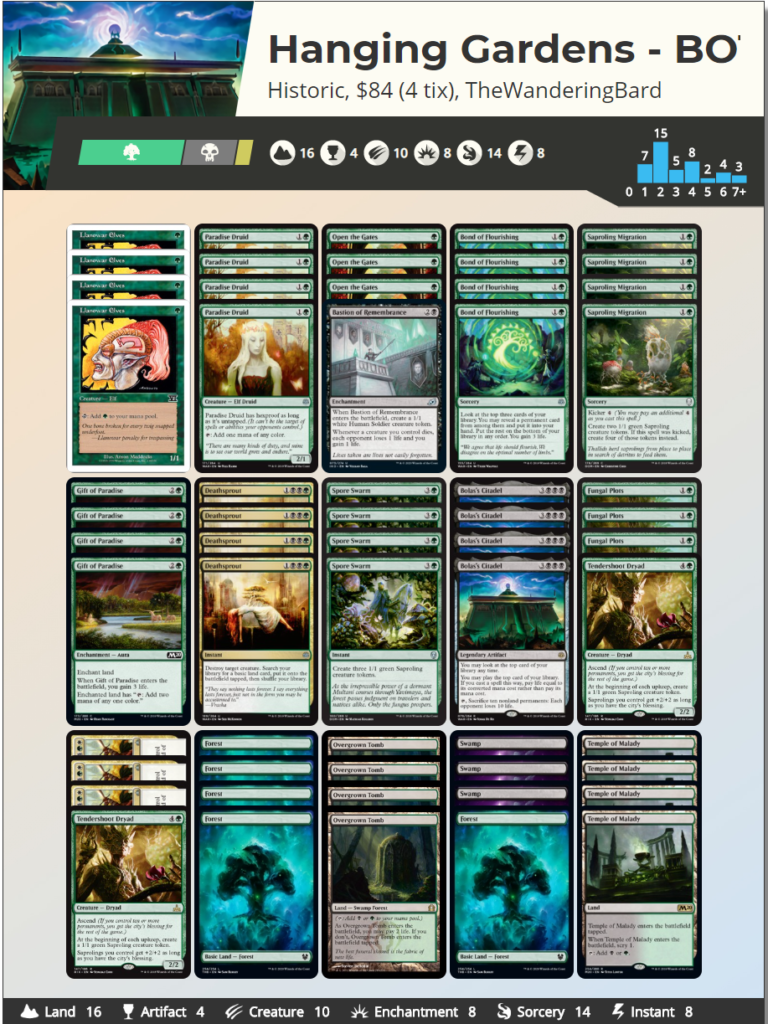
The saproling theme also lands us in green, which is the best place to build Citadel decks. You can go deliciously low on actual lands in favor of mana dorks, Flower//Flourish, Bond of Flourishing and Open the Gates. Traveler’s Amulet actually lets you go even deeper on these effects, but you can end up spending all your mana in the early game just to hit your land drops, which is counterproductive. Luckily, if you get the balance right, you can fend off non-trampling aggression with saproling tokens.
QUICK TIPS:
- You can almost always win on the turn you untap with Citadel, if not when you play it. Play through your deck until you find another Citadel on top, then see if you can activate your current one without losing all Plots/all saprolings/your current Citadel. You can then play the second Citadel and keep going to reach a second activation.
- If you can’t cast two Citadels, you can play until you hit the copy of Bastion of Remembrance, which hopefully gives your first activation extra punch.
- You can cast Flourish off the top of the deck using Citadel for six life if it will pump enough saprolings to set up lethal.
- There are only THREE situations where you should draw with Fungal Plots: when you or your saprolings are about to die anyway; when you’re trying to combo off but there’s a land on top of your library; and sometimes when there’s a Citadel on top and you don’t want to burn six life.
- Try to grab Swamps when you cast Open the Gates unless you need the green; Flower can only grab Forests, and you want to maximize deck thinning. Similarly, grab a non-basic off Bond of Flourishing if you have a choice of lands.
- Even when you don’t have a Citadel ready, play as though you’re about to draw it. Keep ramping, keep generating food with Gilded Goose (if you play it) or extra saprolings with Plots.
- It’s okay to chump-block with mana creatures if you have to. You’re mostly just trying to have 3BBB ASAP, and creature cards in graveyards can become saprolings with Plots.
- Tendershoot Dryad is a decent saproling generator, but also provides an alternate win-con against slower, fairer opposition.
3. RESOLVE A ONE-SIDED ARMAGEDDON
But what if you want a deck that’s a bit more defensive, and “goes off” with mass land destruction instead of an immediate combo? As an avowed fan of Armageddon and land destruction in general, I’ve been searching for ways to use Fall of the Thran since a brave design team printed it into Dominaria.
The reason they were able to put a mass land destruction spell in Standard at all is by A) making it cost six and B) sticking two chapters of apology note to it. You’re only really buying yourself a bit of time for that hefty investment, since in two turns’ time, your opponents will have gotten most of their lands back from the ’yard. Unless, that is, something unfortunate happened beforehand…
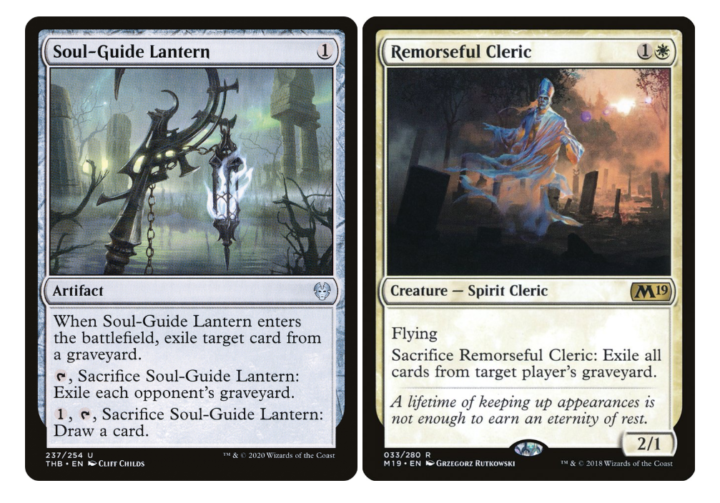
It turns out that exiling opposing graveyards is something players already need to do a lot in Magic thanks to an endless parade of recursion mechanics. We’re even getting a Tormod’s Crypt reprint next set! So all we need to do is set ourselves up with an innocuous Lantern, get to six mana, and drop Fall of the Thran, then exile our opponent’s graveyard before the second chapter resolves. At that point, we start rapidly recovering lands while our opponent has stone nothing — if they don’t concede on the spot.
Let me assure you: a lot of people concede.
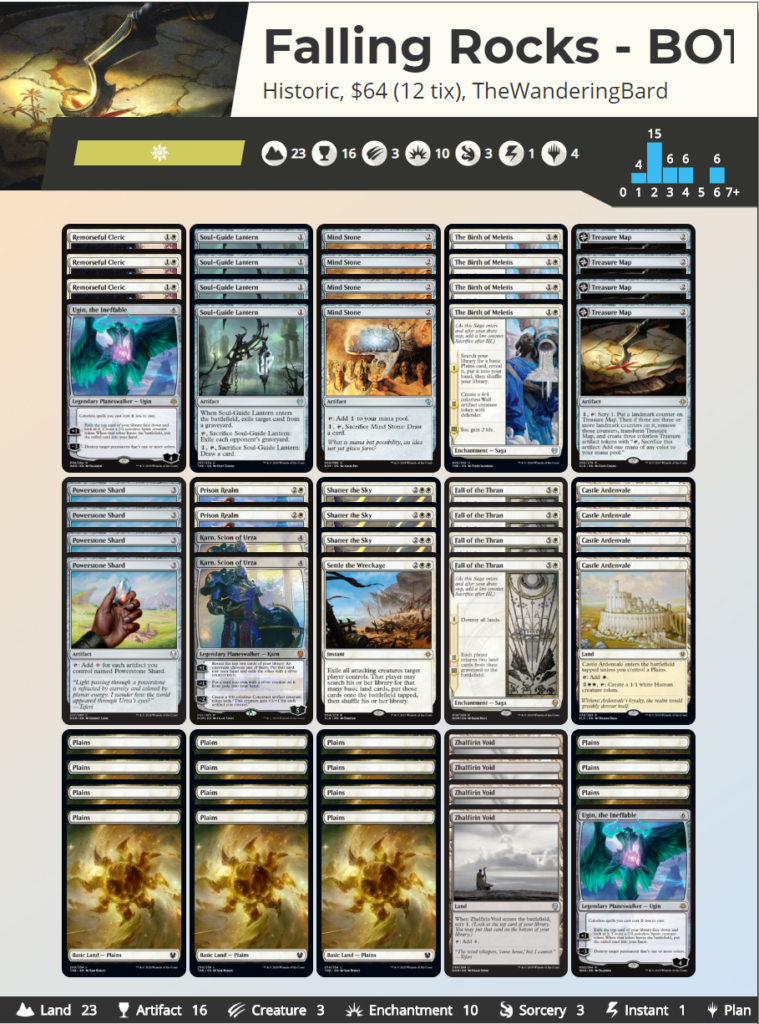
I started out in Best of One with this mono-white build. This build overloads on mana rocks (and another pet card of mine, Treasure Map) to ensure you get to six mana for Fall in a timely manner. Rocks also stick around after Fall to cement your mana advantage. Lantern, Mind Stone and Treasure Map can also dig through your deck faster and find your big spells on time. Playing this many artifacts also facilitates our finishers, Karn and Ugin, who also generate gradual card advantage. It’s a satisfyingly complete package for a white deck.
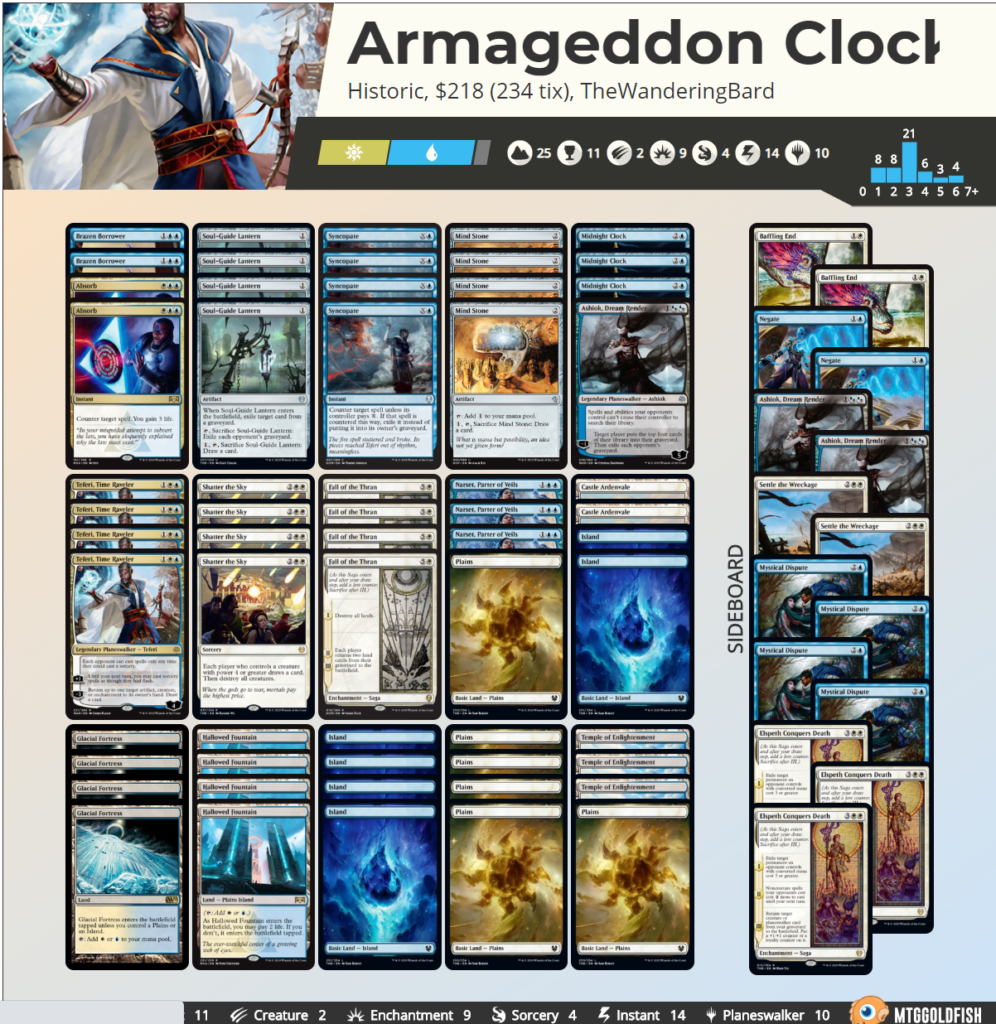
But since every combo deck is better with Teferi, Time Raveler, I knew I had to try and assemble a UW control version. This one fares much better in Best of Three, being able to protect its combo and having enough game outside of the Fall to divert their attention so we can land it. This ends up being UW control with a different sort of “threat,” one which is super-effective against other slow decks and a little less reliable against fast ones. But boy, is it fun.
QUICK TIPS:
- Midnight Clock is both an accelerant and your secret win-con if opponents don’t concede to your first Fall. It’s often correct to throw spare mana into speeding it up on your end step if you don’t have a Fall in hand.
- If the Clock strikes twelve after you cast Fall, it will shuffle away the lands in your graveyard! This slight non-bo is rarely game losing, but you want to keep track of it. Clock gains counters on both players’ upkeep, while Fall only advances on your main phase.
- Lands returned to play by Fall enter at the same time, and do not “see each other” enter the battlefield. If you need access to blue mana, don’t return Plains + Glacial Fortress — return Plains + Island.
- If you’re worried about counterspells, it can be worth bringing in Elspeth Conquers Death. The second chapter is “free protection” for your combo, and it makes it easier to get Teferi and Narset out together.
- The best play pattern against creature decks is to cast Shatter as close to Fall as possible, so that you aren’t taking damage from their board while recovering your lands. Then you can use your bounce spells and counters to keep them from rebuilding.
4. DROP AN ANGRY CITY ON SOMEONE
Weren’t the Ixalan flip-lands cool? You know, the ones that started out as some enchantment or artifact and then turned into good utility lands, effectively ramping you into the bargain? Wasn’t it a bit lame that only Legion’s Landing and Search for Azcanta saw real play? Let’s fix that.

There are a wealth of different ways to build Climb, many of which are strong (ask me for other lists on Twitter). But this shows off the fundamentally good stuff. You have interaction, card advantage, and ramp — much of it coming from creatures that also interact well with Climb. The surprise weapon here is Awakening of Vitu-Ghazi; it’s so good that this could nearly be called a combo shell, despite the amount of other powerful things going on.
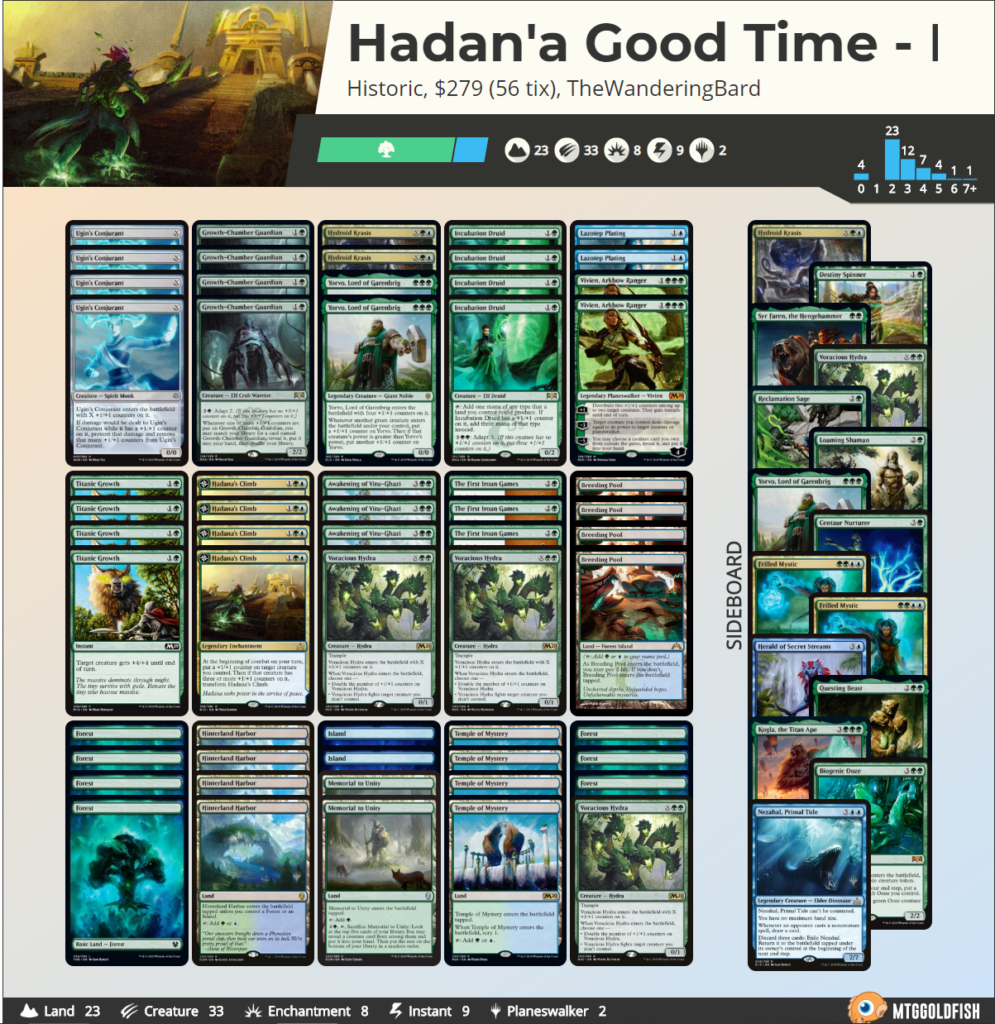
Very simply, flipping Climb should leave you with at least five mana available. Since Awakening is an instant, you can cast it on your opponent’s end step when shields are down, then untap with a 9/9 and exactly enough mana to launch it into the sky for 18. Nobody sees it coming.
QUICK TIPS:
- Incubation Druid seems weird to play over Llanowar Elves, and it’s possible both are correct. But turn two Druid into turn three Climb leaves us with a similar or better position, and the Druid’s adapt ability is extremely valuable in this deck.
- Syr Faren the Hengehammer resides in the Vivien-board for this build, but playing a few copies of him alongside Titanic Growth, Collision//Colossus and The First Iroan Games can be beneficial.
- Another main deck option is Herald of Secret Streams, which will completely blindside creature decks.
- Lazotep Plating might be the best possible answer to Teferi, Time Raveler short of countering it. Casting it in response not only makes it impossible for Teferi to bounce your permanents, but gives you a bonus 1/1 (also hexproof) to attack him with.
- Plating is in over actual counterspells because we should hopefully only worry about things which affect our board. Hexproof can “counter” targeted abilities as well as spells.
- If your Growth-Chamber Guardian already has counters on it, putting additional counters on it still gets you an extra copy.
- Winged Temple activation doubles a creature’s current power — stack up your Titanic Growths and other buffs prior to activation.
5. MAKE A FORTUNE CRACKING EGGS
For my last daring Historic feat, let’s bring it all back around to Kinnan. Kinnan is some real nonsense, yolks. Wait, yolks?
The humble Magic egg — generally, a class of cheap artifacts that generate some small effect and refund the cards and/or mana spent to play them. They’re essentially free triggers, which makes them instrumental in a number of combo decks. However, Kinnan’s effect is worded such that when you crack Golden Egg or Guild Globe for mana, you actually get back more mana than you spent! You can use eggs as a kind of weird, clunky ritual! Are you egg-cited?
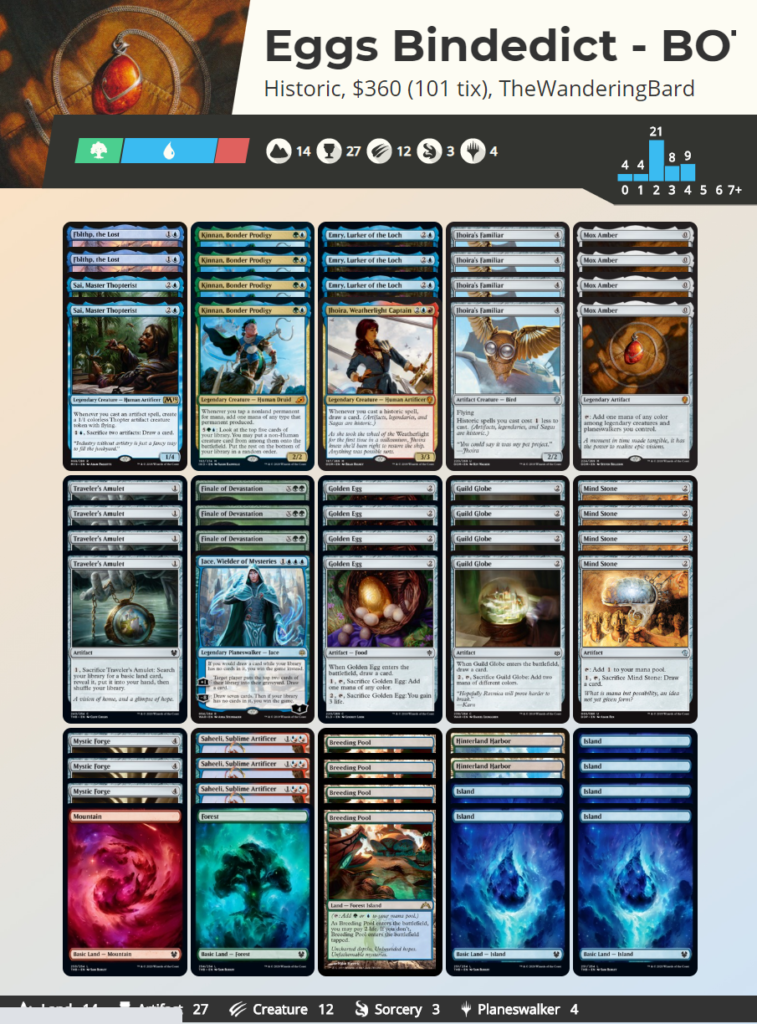
Since there are no actual storm cards in Historic (Thousand-Year Storm requires instants and sorceries), we’ll have to build our engine to burn through our whole deck and win with Jace again. Sai, Master Thopterist and Saheeli, Sublime Artificer will provide backup lethal from tokens, which can also block for you as you’re getting set up.
Since you’re quite dependent on Kinnan, you can use Finale of Devastation for extra copies. This also lets you find pieces that improve your combo: Jhoira, Weatherlight Captain and Jhoira’s Familiar. Kinnan lets you profit from activating eggs, but not enough to offset their casting cost the same turn. (Once you have a Familiar, you break even, and with two Familiars, you’re officially gaining mana while cantripping.)
Mystic Forge is the final piece of the puzzle. In a deck with this many artifacts, it’s a no-downside Bolas’s Citadel. The deck’s play pattern amounts to trying to lob as many of these key permanents into play as you can, accelerating as you go, until you can draw your last 40 cards in one go. There’s no real interaction, but there is a lot of redundancy and recursion to get you over the line.
This list can consistently Mystic Forge through the whole deck. Many cards cantrip when you cast them, and Jhoira makes all of them cantrip. The one exception, Finale, can be cast for X=0 if you need a shuffle. Mind Stone draws on activation, Traveler’s Amulet shuffles, and Mystic Forge itself can delete your top card. Saheeli can turn an egg or token into one of those three. Emry mills you and can activate to cast an egg from the ’yard.
All this means you should focus on assembling Kinnan + Familiars + Forge + Jhoira. The rest takes care of itself — a self-cooking omelette.
QUICK TIPS:
- While eggs are sometimes useful for filtering mana, you should otherwise save them until you’re going off. Ideally, wait as far into your combo turn as possible so you know you aren’t wasting them. Eggs are for sizzling, not fizzling!
- Kinnan improves the return on eggs, but you still need to put mana in to activate them. When you’re going off, try to keep your mana pool as full as possible, cracking all your eggs ASAP.
- Remember that Finale can dig up creatures from your graveyard — useful if your sole Jhoira dies. Don’t underestimate its flexibility, either — every creature in the deck is a strong target.
- This deck is fine playing a singleton copy of Jace. You’re statistically unlikely to draw him until you’re going off, so you’re unlikely to have him discarded or killed. You also don’t need to play him after already drawing your deck, so you’re not as blown out when he gets countered. If that does happen (or if Emry mills him), then you should slow down a touch and play for the token army lethal.
- Alternatively, you can play Thassa’s Oracle to have Finales as backup copies.
- Sai and Saheeli are more than just token generators! Sai can draw cards in a pinch, and Saheeli can turn your random servos and thopters into Mind Stones, Mox Ambers, or Familiars for bonus mana!
It’s no exaggeration to say there are likely hundreds of viable Historic decks at present, some of which I played against while I was testing these five! I’d invite any reader who misses a particular Standard card or pines for one that never made the cut to try building in the format. And if you need any inspiration, just hit me up on Twitter — I know this process has only primed my appetite for fresh brews!

Tom’s fate was sealed in 7th grade when his friend lent him a pile of commons to play Magic. He quickly picked up Boros and Orzhov decks in Ravnica block and has remained a staunch white magician ever since. A fan of all Constructed formats, he enjoys studying the history of the tournament meta. He specializes in midrange decks, especially Death & Taxes and Martyr Proc. One day, he swears he will win an MCQ with Evershrike. Ask him how at @AWanderingBard, or watch him stream Magic at twitch.tv/TheWanderingBard.

